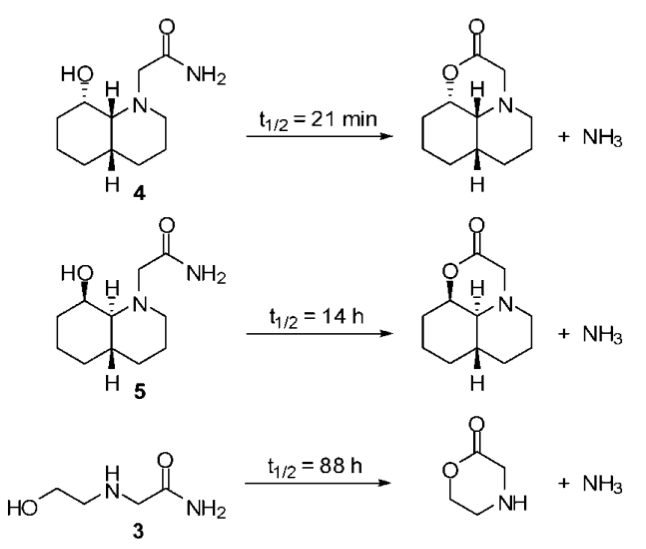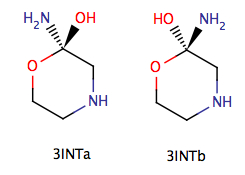[source]
In a previous posts I showed how to find the TS for hydrolysis of 3 at the RHF/3-21G level of theory. In this post I show how to compare the computed results with the experimentally observed half-life (t1/2) of 88 hours.
The half-life is connected to the the rate constant for the reaction (k) by
 (1)
(1)
The rate constant can be estimated from the activation free energy (ΔG≠) by transition state theory:
 (2)
(2)
(here the units are those of a unimolecular reaction). The activation free energy is the free energy of the TS relative to the reactantIn a previous posts I showed how to find the TS for hydrolysis of 3 at the RHF/3-21G level of theory. In this post I show how to compare the computed results with the experimentally observed half-life (t1/2) of 88 hours.
The half-life is connected to the the rate constant for the reaction (k) by
 (1)
(1)The rate constant can be estimated from the activation free energy (ΔG≠) by transition state theory:
 (2)
(2)ΔG≠ = G(3TS) - G(3) = ΔE≠+ ΔG≠TRV
Which can be rewritten as the difference in electronic energy and the free energy correction due to translation, rotation, and vibration. I showed how to extract the RHF/3-21G electronic energy (-413.5161 Hartrees) and free energy correction (81.841 kcal/mol) for the 3TSa in a previous post.
In the screencast at the end of the post I show how to obtain the corresponding values (-413.6014 Hartrees and 82.889 kcal/mol) for 3. So,
ΔG≠(3TSa) = (-413.5161 - (-413.6014))*627.51 + (81.841 - 82.889)
= 52.5 kcal/mol
= 52.5 kcal/mol
You can get the corresponding experimental number from the half life (88 hours) and equations (1) and (2): 25.1 kcal/mol and, yep, the RHF/3-21G activation free energy is way off. The corresponding barrier for 3Tsb (51.0 kcal/mol) is only a little better.
There could be many reasons why the activation free energy is so severely overestimated. Two of the most likely suspects are:
1) Level of theory. TS structures, and therefore the underlying wavefunctions, tend to be more complicated than the minima structures. Thus, larger basis sets and electron correlation methods may be needed to obtain accurate activation free energies. This tends to lower the energy of the TS more than the minima, thus lowering the barrier compared to lower levels, but this is not always the case.
2) A different reaction mechanism. What might seem the most straightforward path from reactants to products is not always the one with the lowest barrier. For example, in the case of amide hydrolysis a stepwise mechanism is also possible in which the hydroxyl hydrogen is transferred to the carbonyl O atom to create a (chiral) intermediate.
TSs corresponding to such a mechanism must also be found to see if they lead to lower activation free energies. If you followed the last few posts of finding TSs you now have all the skills needed to do that.
Here is the screencast that shows how to find the energies for 3:
I paste in the following set of keywords
$contrl runtyp=optimize $end
$system mwords=125 $end
$statpt opttol=0.0005 nstep=50 hssend=.t. $end
$force nvib=2 $end
$contrl nzvar=1 $end
$zmat dlc=.t. auto=.t. $end
In the RHF/3-21G optimization + frequency run I forgot to add
$scf dirscf=.t. $end
which would have speeded up the calculation, as I described in a previous post.






No comments:
Post a Comment